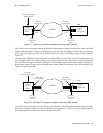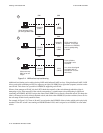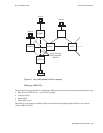
2-16 SmartSwitch ATM User Guide
Creating an Emulated LAN IP Over ATM and LANE
Currently, the SmartSwitch 6500 is the only SmartSwitch ATM switch that supports logical multicasting. For this
reason, if you are connecting to LANE services across an ATM WAN using multiple PVPs and if client join requests
for the same ELAN are received over different PVPs, you must use a SmartSwitch 6500 as the LANE services switch.
If on the other hand, your WAN connection consists of a single PVP, any of the SmartSwitch ATM switches can be
used as the LANE services switch.
The rules for selecting the appropriate SmartSwitch ATM switch for providing LANE services across an ATM WAN
are summarized below:
• A single PVP connection terminated on the LANE server switch with a single virtual port — Any
SmartSwitch ATM switch as the LANE server (physical BUS multicasting)
• Multiple PVP connections terminated on the LANE server switch through virtual ports on the same
physical port, where each PVP supports client connection requests for separate ELANs — Any
SmartSwitch ATM switch (physical BUS multicasting)
• Multiple PVP connections terminated on the LANE server switch through virtual ports on different
physical ports — Any SmartSwitch ATM switch (physical BUS multicasting)
• Multiple PVP connections terminated on the LANE server switch through virtual ports on the same
physical port, where each PVP supports client connection requests for the same ELAN —
SmartSwitch 6500 only (logical BUS multicasting required).
2.2.7 Using LNNI
SmartSwitch ATM switches provide support for LNNI. LNNI gives LANE redundancy and load-sharing capabilities
by allowing multiple LECSs to exist on the same network, and by allowing multiple LES/ BUSs and SMSs to service
the same ELANs.
Note For an explanation of all LNNI related commands and parameters, see the
SmartSwitch ATM Switch Reference Manual.
LANE Service Redundancy
As many as eight (8) LECSs (one per SmartSwitch ATM switch) can be deployed on the same network; each LECS
can support multiple ELANs. This is especially useful on large, mission-critical networks and eliminates the possibility
of the LECS being a potential single point-of-failure. If, for some reason, LANE services go down on a particular
switch, the clients that this switch supports can reestablish their connection to their ELAN through one of the other
LECSs (see Figure 2-3).


















